This post may contain affiliate links. Please read our disclosure policy.
THIS IS IT GUYS! The vegan cheese you have been looking for. Sharp, and creamy with a white and flowery rind, this vegan camembert is simply mind-blowing! Made using traditional cheese-making techniques and just 5 ingredients!
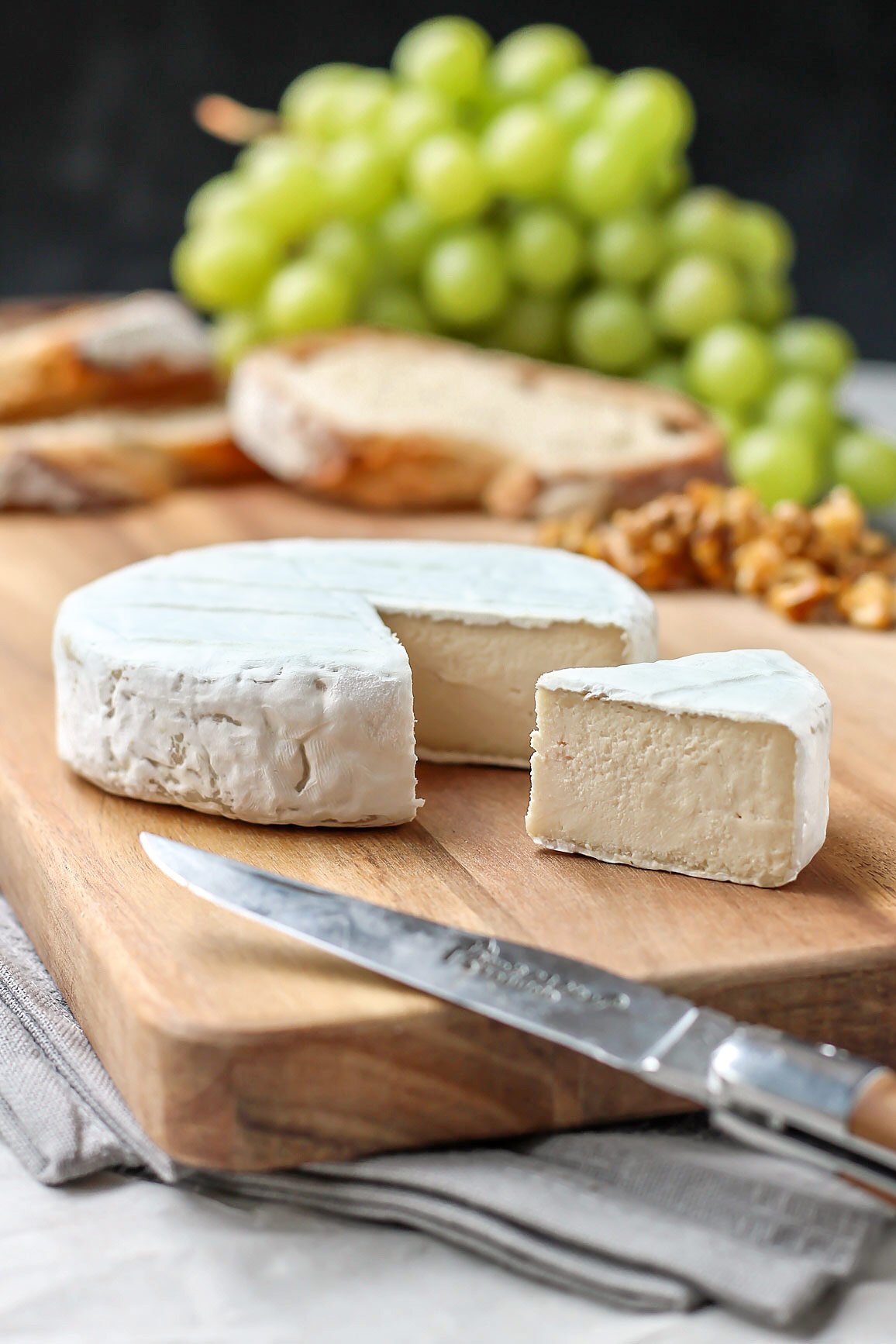
After months of research and testing, I finally found how to make a nut cheese with the taste and texture of a real camembert. Living in France, I ate quite a lot of artisanal cheese before going vegan, and I can tell you this one seriously taste like a real one.
⭐️ Why You Should Try This Recipe
- The flavor and texture are incredible. Creamy on the inside, slightly chewy on the outside, and perfectly tangy, I can confidently say this vegan camembert tastes SO much better than most other vegan cheese recipes.
- Made using traditional techniques. While cashew cream replaces dairy milk here, we are using traditional cheese-making methods to age this cheese, giving it a true cheese aroma. There is no nutritional yeast or flavorings used here. It all comes from the cultures and the aging process.
- The reviews speak for themselves. With over 250 ★★★★★ ratings, it’s no question readers love this camembert!
- It’s healthy. This vegan camembert is packed with healthy fats and probiotics that can help improve gut health.
📘 What is Camembert
Camembert is a soft and creamy cheese that first appeared in Normandy, France, around 1554. It is inoculated with a mold called “Penicillium Candidum”, responsible for producing a bloomy rind, and is usually aged for 2-3 weeks.
Looking for other vegan cheese recipes? Check out my vegan blue cheese, sun-dried tomato camembert, hickory-smoked, or this super unique washed-rind vegan cheese!
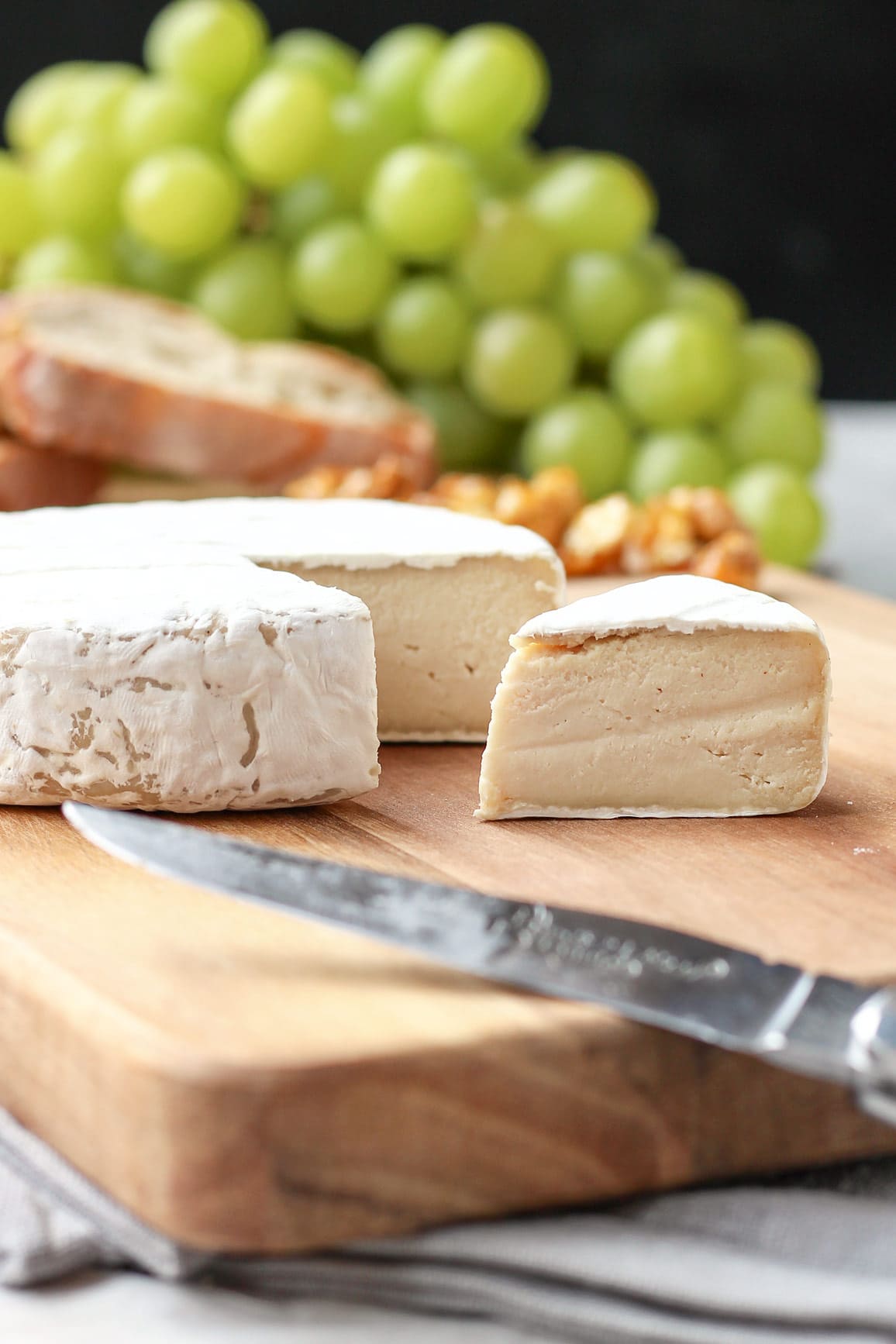
🥛 Ingredient Notes
This cheese contains only FIVE ingredients: raw cashews, cultures, water, salt, and the secret ingredient for the rind: Penicillium Candidum. Here are some notes about each ingredient:
- Cashews – Cashews make the base of this cheese. You want to use raw cashews, not roasted ones.
- Probiotics – These will give the cheese its tanginess. You can use acidophilus or mesophilic culture. Check out the Tips to read more about it.
- Penicillium Candidum – Penicillium Candidum is a mold that grows on camembert/brie and gives it a white and soft rind. It also adds a lot to the taste by giving a mushroomy flavor. It’s an essential ingredient to this recipe and cannot be omitted or substituted.
- Water – To blend the cashews and turn them into a cream. I recommend using filtered water or water that has been boiled and cooled down.
- Salt – For flavor and to prevent bad bacteria from growing.
🥣 How To Make Vegan Camembert
Before starting: Be aware this is not a quick recipe, don’t expect to have vegan camembert ready tonight. The whole process will take you about three weeks. BUT: It is totally worth it!
1. Prepare the cashew cream
- Drain the soaked cashew and transfer them to a high-speed blender. You can use a food processor, but you won’t get the same silky smooth texture.
- Add the water and blend on high speed for 1-2 minutes or until it forms a thick and smooth cream.
- Sprinkle the acidophilus probiotic and the Penicillium Candidum and blend for another 5-10 seconds.
Note: There are two methods to innoculate the Penicillium Candidum. The first one consists of mixing it into the ingredients directly. The second one consists of spraying it on the outside of the cheeses after they have been shaped. I used the first method here, which gives the best result, in my opinion.
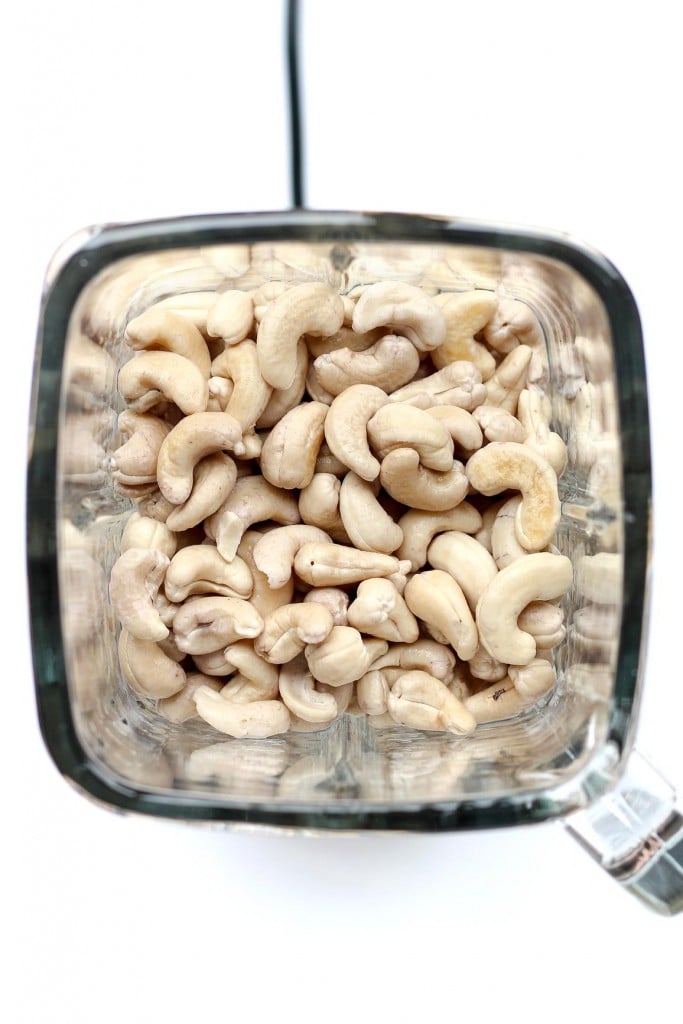
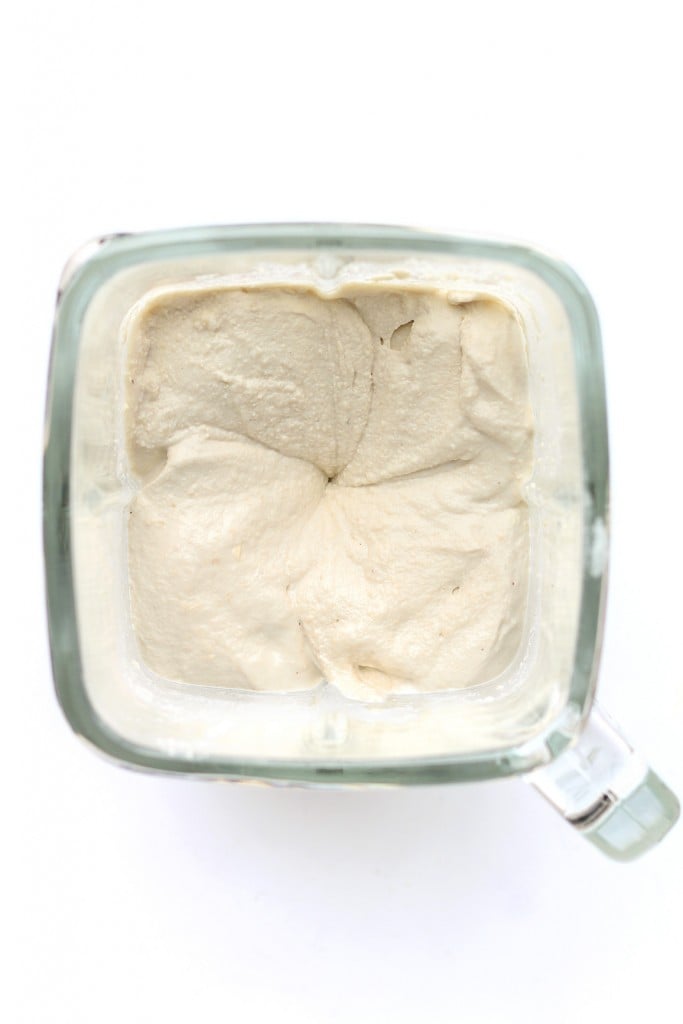
2. Let the cashew cream ferment
Once you have a very smooth and thick cashew cream:
- Transfer it to a clean bowl and cover it with plastic film to touch.
- At this point, let the cashew cream ferment at room temperature in a dark place for 24-48 hours.
- After that, the cashew cream should have small bubbles and a fluffy texture. This means the fermentation process worked. You can taste it. It should have a subtle tanginess.
- Transfer the fermented cashew cream to the refrigerator and chill for at least 4 hours or overnight. This step will allow it to firm up a little bit.
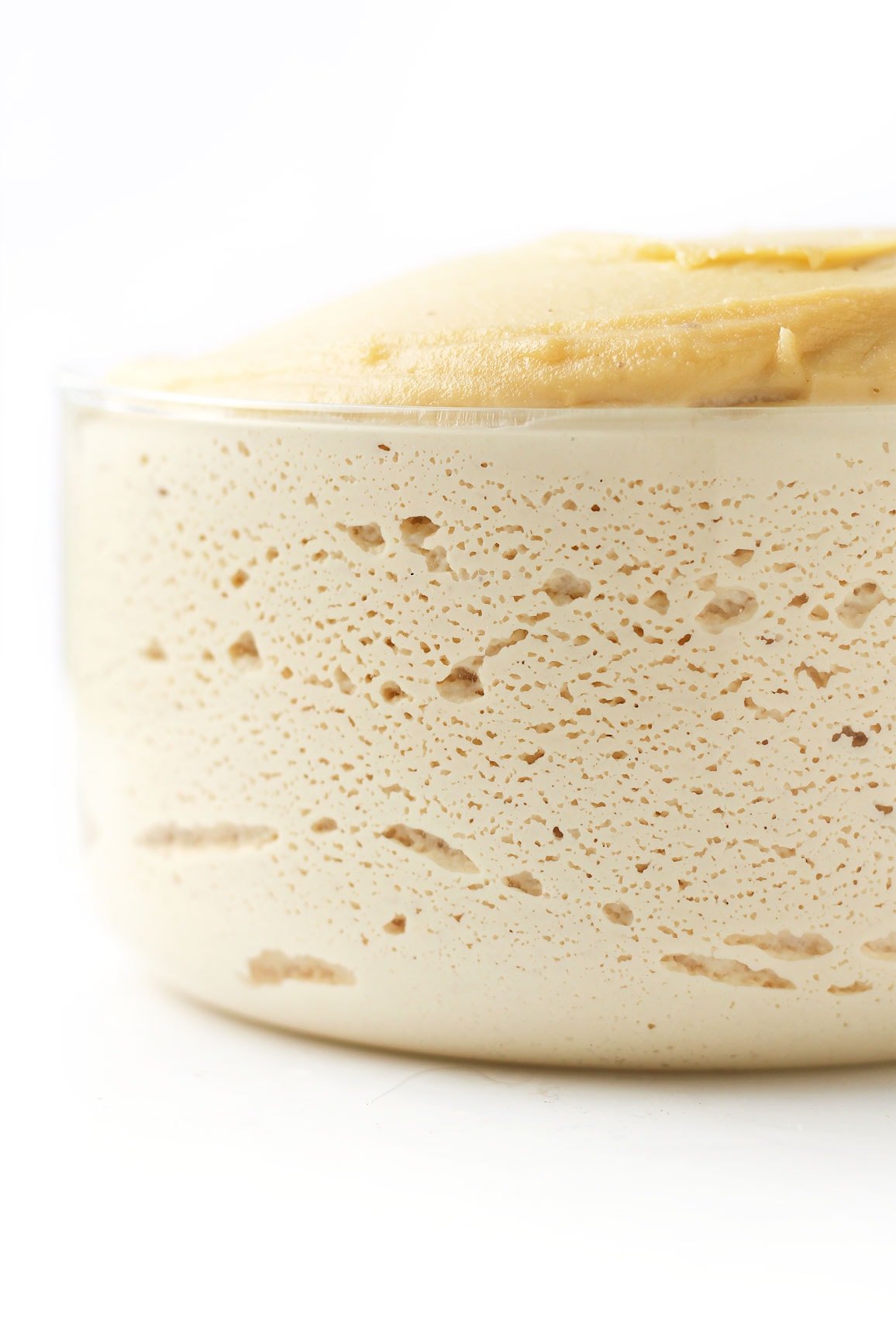
3. Shape and salt the cheeses
- Line 3 springform pans (I used these Wilton 4-inch springform pans) with parchment paper or plastic wrap, covering the bottom and sides. The goal is to prevent the cheese from touching and sticking to the metal.
- Fill each pan with the cashew cream mixture and press it down using plastic film, so it doesn’t stick to your hands. Cover with plastic film to touch.
- Refrigerate overnight.
- The next day, carefully remove the cheeses from the springform pans and place them in a container lined with parchment paper. Be careful, the cheeses will be very soft (like a thick cream).
- Sprinkle about 1/4 tsp of salt over the top of each cheese, and rub with your finger to evenly distribute the salt. Carefully flip the cheeses and sprinkle the bottoms and sides with more salt.
- Close the container and place it in your refrigerator (in the warmest area) or a room at a temperature of 52-56°F (11-13°C).
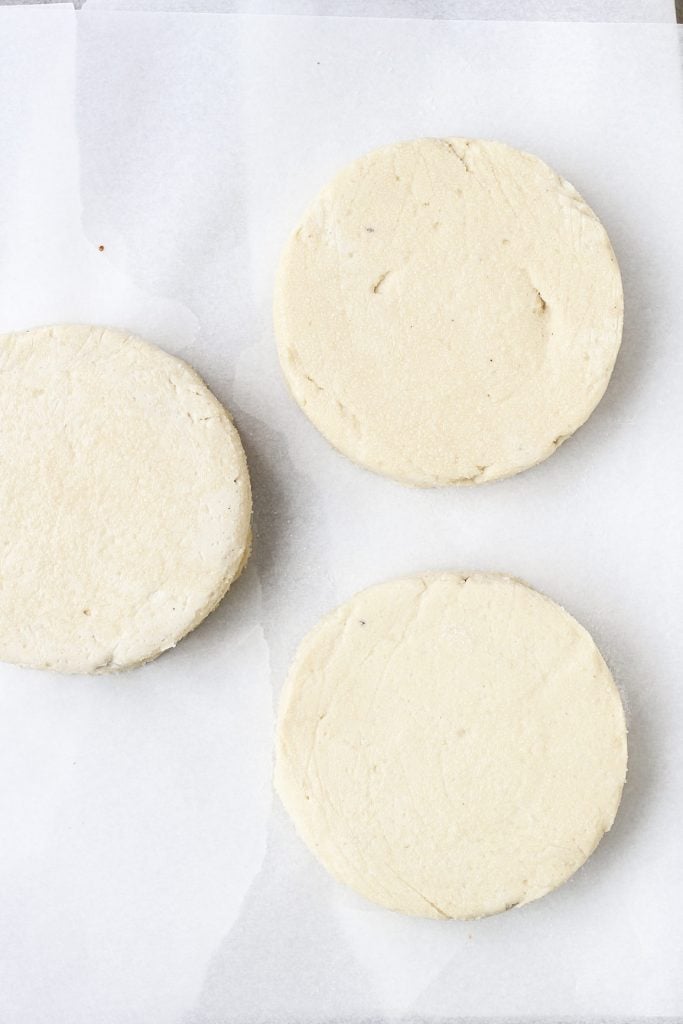
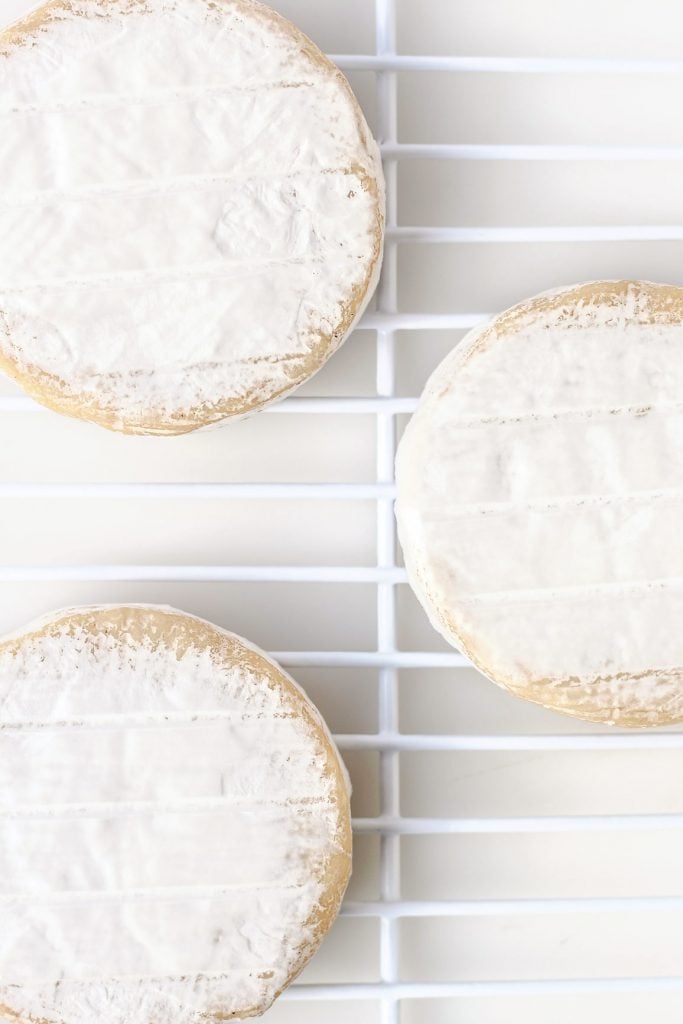
4. Age the cheeses
Finally, the most exciting step!
- Every day, carefully flip the cheeses. The cheeses will be very soft at the beginning, like cream cheese. Don’t worry; they will firm up after a few days. If you see water or condensation in the container, remove it using a kitchen paper towel.
- After 7-10 days, the cheeses should be slightly firmer. At this point, you can place them on a clean grid (that fits in your container). If you don’t have a grid, place the cheeses on chopsticks. This will allow airflow, and the mold will grow more uniformly.
- Continue flipping the cheeses every day for the next 7 days. The mold will start to appear in the following days if it hasn’t appeared already.
- After a total of 2 weeks, the cheeses should be fully covered with a white and fluffy rind. You are almost done!
- Wrap the cheeses in parchment or cheese paper and place them in the refrigerator for at least 2 days. The longer you let them age, the sharper they will become.
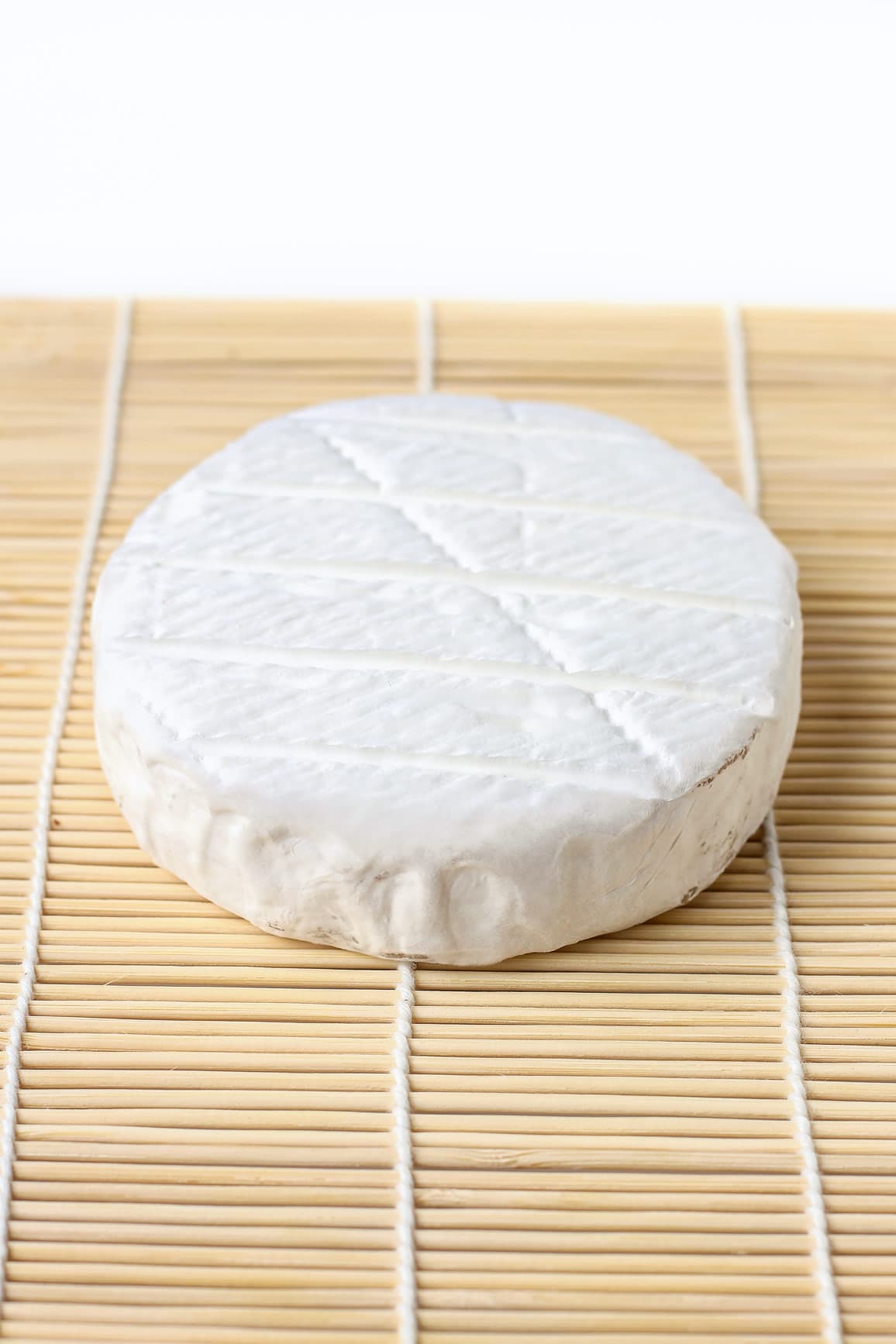
🥖 How To Serve It
Enjoy with french bread, Vietnamese baguette, fig chutney, caramelized walnuts, or even a drizzle of pure maple syrup if you like the combination of sweet and salty.
Regarding beverages, this camembert pairs well with cider, Champagne, Cabernet Sauvignon, apple liquor, beer, or a good apple juice if you don’t drink alcohol. The apple undertones of cider or apple juice contrast very well with the slight bitterness of the camembert!
❄️ Freezing
After aging the cheeses, wrap them in cheese paper or plastic film. You can keep them in the freezer for up to 3 months. Thaw overnight in the refrigerator.
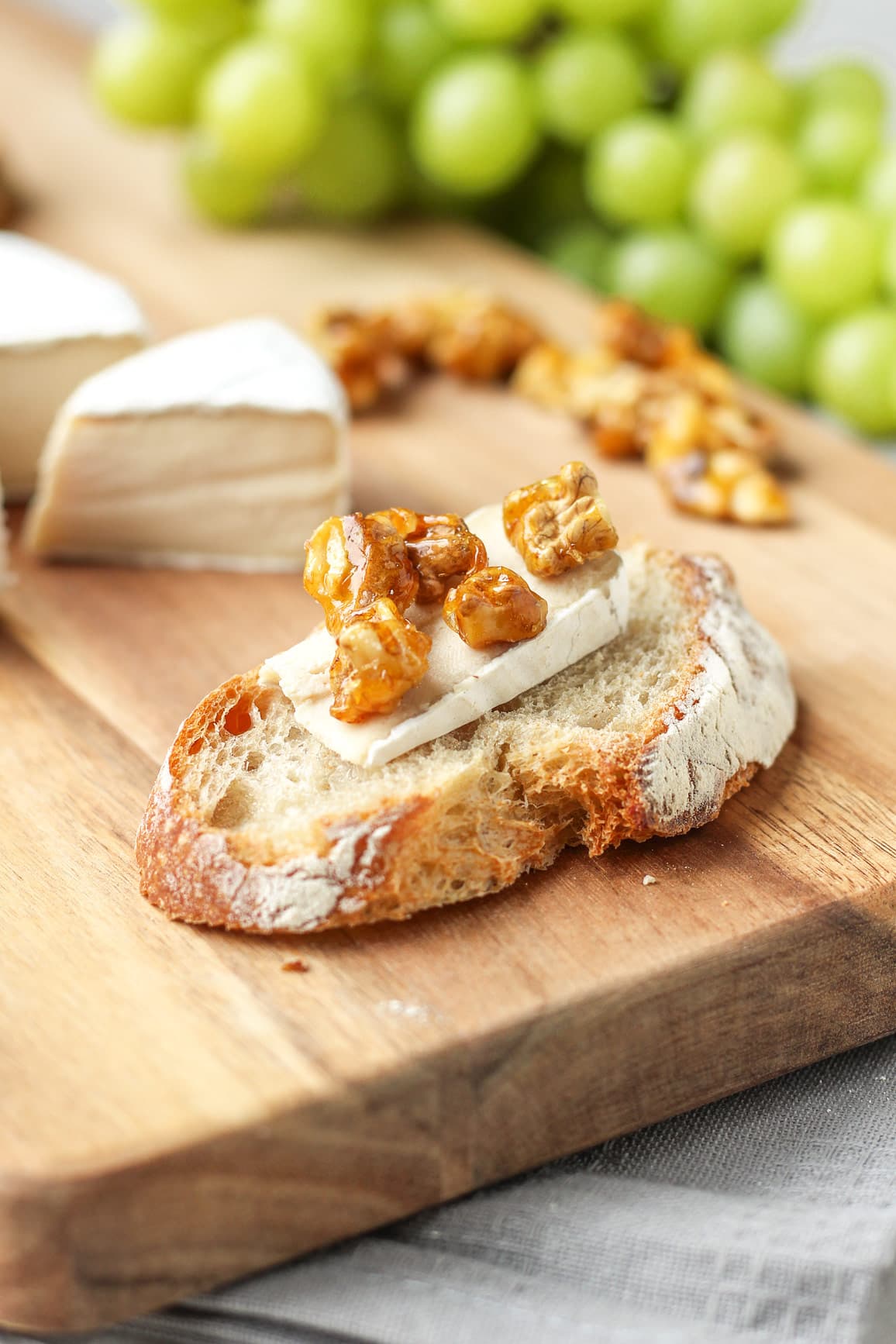
📔 Tips
- Do not omit or substitute any ingredient. This recipe is not versatile. If you want to succeed with it, do not change the ingredients or method.
- Use gloves. While not mandatory, I recommend using gloves while handling the cheeses. It will prevent bad bacteria from contaminating your cheeses.
- Regarding the Penicillium Candidum: The links provided here for Penicillium Candidum may not redirect to a fully vegan product. If you want to find a 100% vegan one, you will have to do your own research (it’s available in many cheese-making shops). Be aware that non-vegan ones are grown on lactose, meaning it contains *traces* of lactose. Considering the amount used, you could still consider your cheese 99,99% vegan. It’s up to you to choose which one fits your beliefs best.
- Regarding the Acidophilus: In this recipe, I used the Advanced Acidophilus Plus from Solgar, which contains 500M microorganisms per capsule. You can use a different brand, but you may have to use less if it contains more microorganisms. Alternatively, you can replace the acidophilus with 1/16 teaspoon of mesophilic, which is a culture made specifically for cheese making. It will yield a slightly less tangy and more buttery flavor.
- Depending on the temperature in your fridge/aging room, the mold might take more or less time to develop. The colder the temperature, the longer it will take to develop.
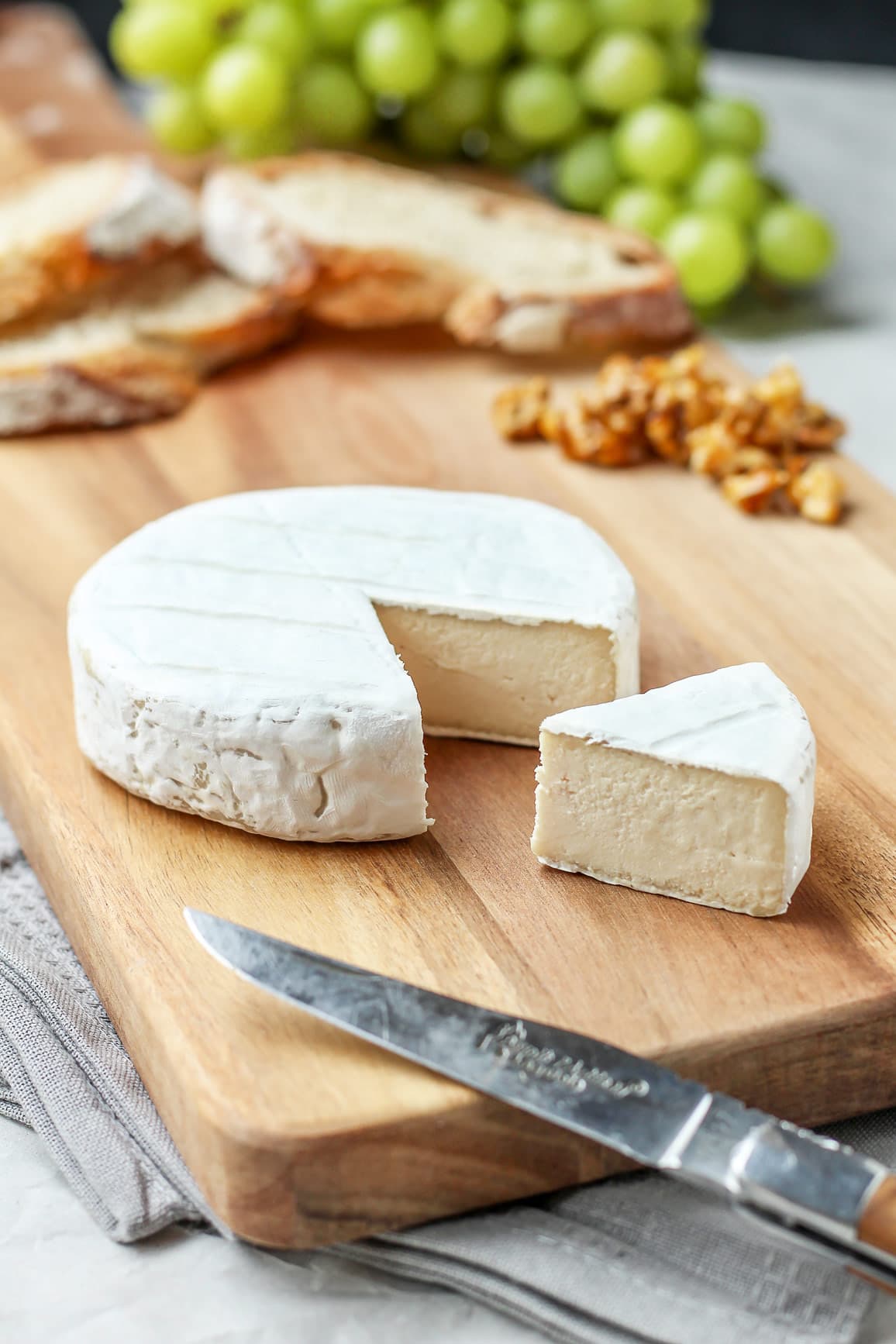
💬 FAQ
Yes! It is totally safe to eat the rind. That’s actually where most of the flavor lies!
Vegan camembert has a nice tanginess and earthiness with notes of mushrooms and butter.
You can find it online on cheese-making websites or ask your local cheese maker to sell you some.
While some readers had success using a mix of different nuts, I haven’t personally tried it yet. I recommend sticking to cashews for a creamy consistency.
No, Penicillium Candidum is essential to this recipe. It’s responsible for the flavor and texture.
After the aging process, vegan camembert will keep for up to one month in the refrigerator, wrapped in cheese paper. Once cut, it will keep for about 1 week.
No, this vegan camembert doesn’t melt but will soften when heated.
Both kinds of cheese originate from different areas of France. One comes from Normandy, while the other comes from “Île-de-France.” The other difference is that Brie is often larger than the camembert, weighing around 100 pounds instead of 9 ounces for the camembert. If you want, you can shape this vegan cheese into a large wheel instead of 3 small ones to make vegan brie!
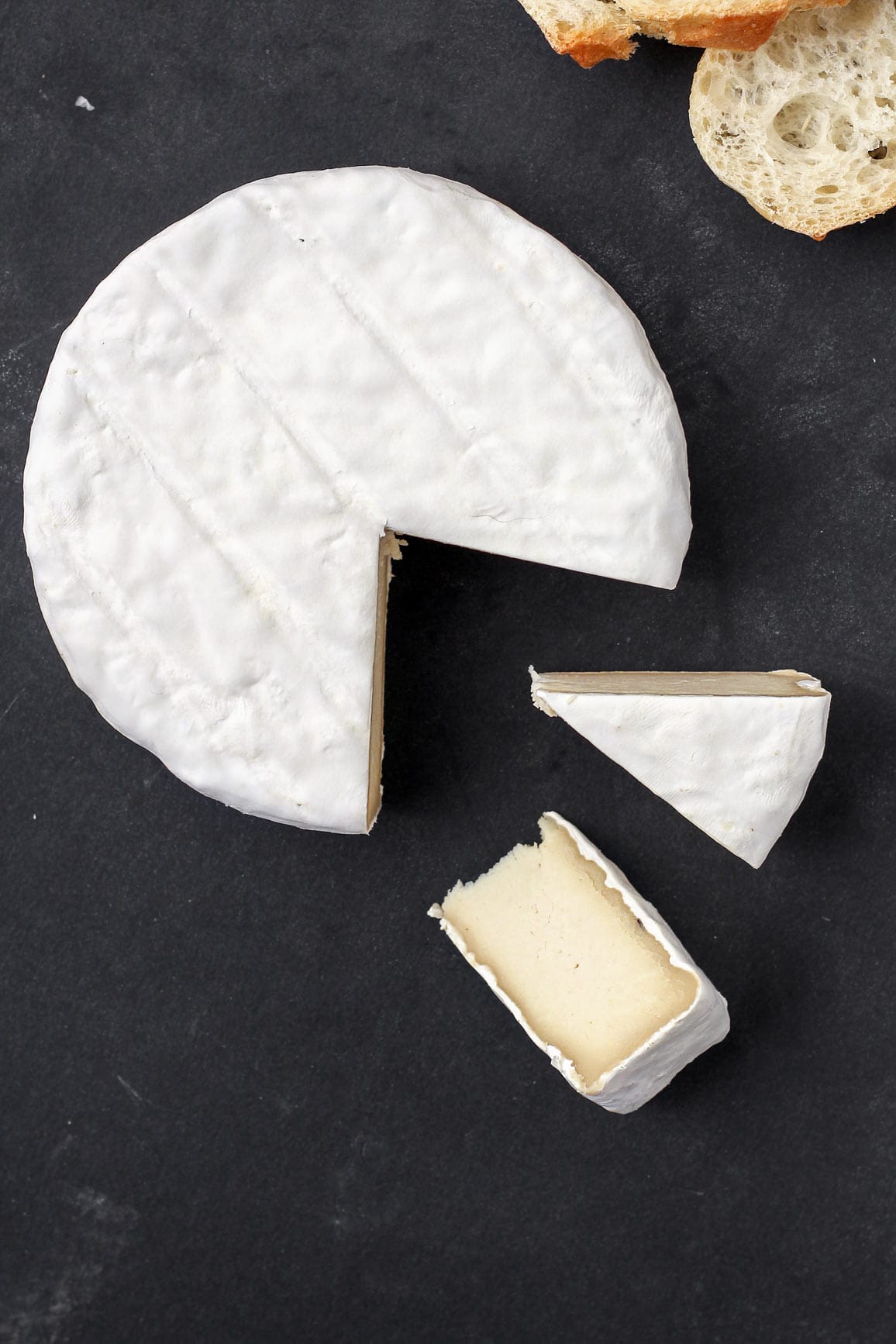
This vegan camembert will surely impress any cheese lover and even your non-vegan friends! It’s creamy, rich, and just delicious!
Disclaimer: Many people have been making this cheese without giving any credit and labeling it their own. I worked really hard to create this recipe and had to do a ton of experiments before releasing it. Please give credit by citing Full of Plants and linking to this website.
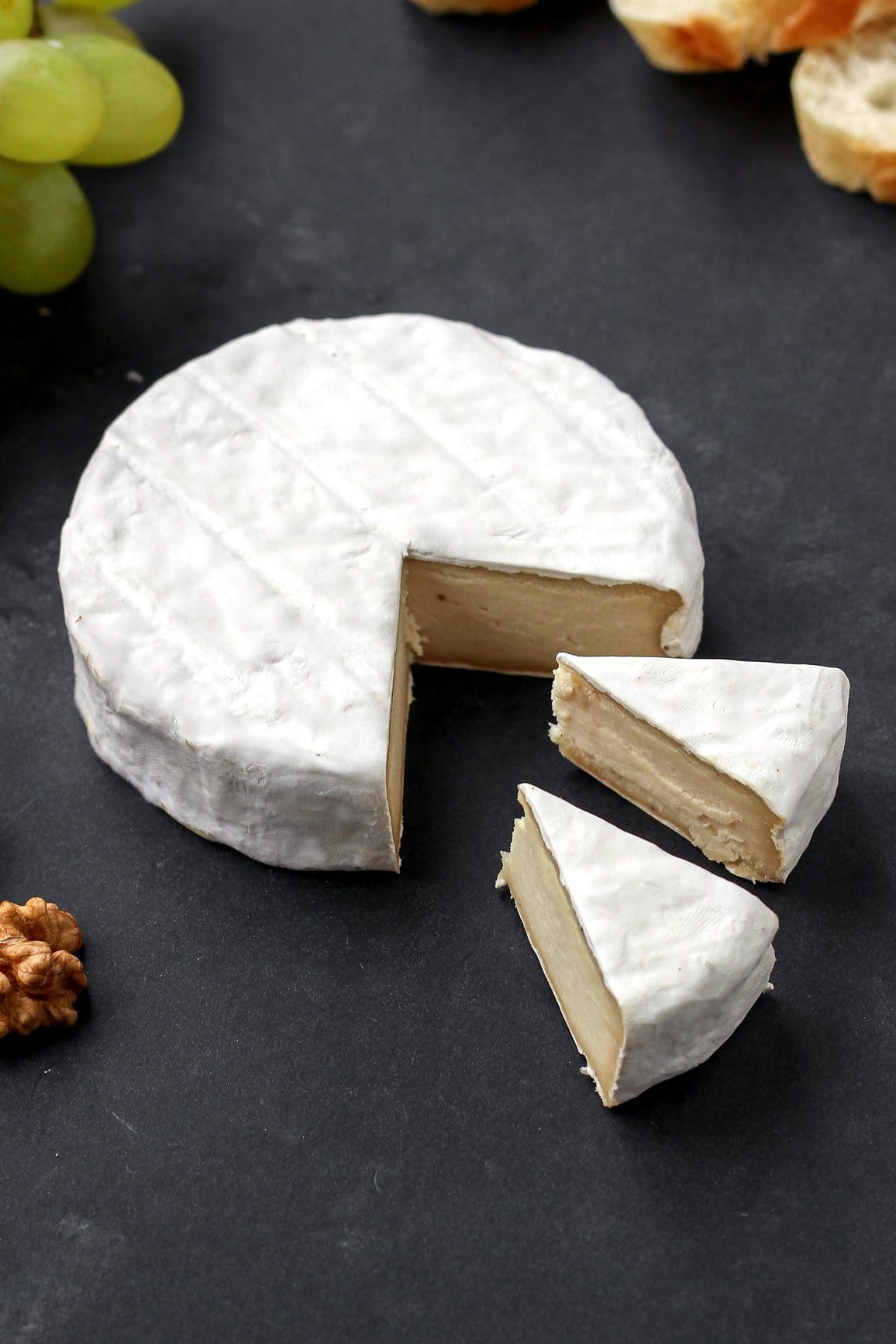

Want to Save This Recipe?
Enter your email below & we’ll send it straight to your inbox! Plus, you will receive new recipes every week!
I’d like to receive more tips & recipes from Full of Plants.
This site is protected by reCAPTCHA and the Google Privacy Policy and Terms of Service apply.
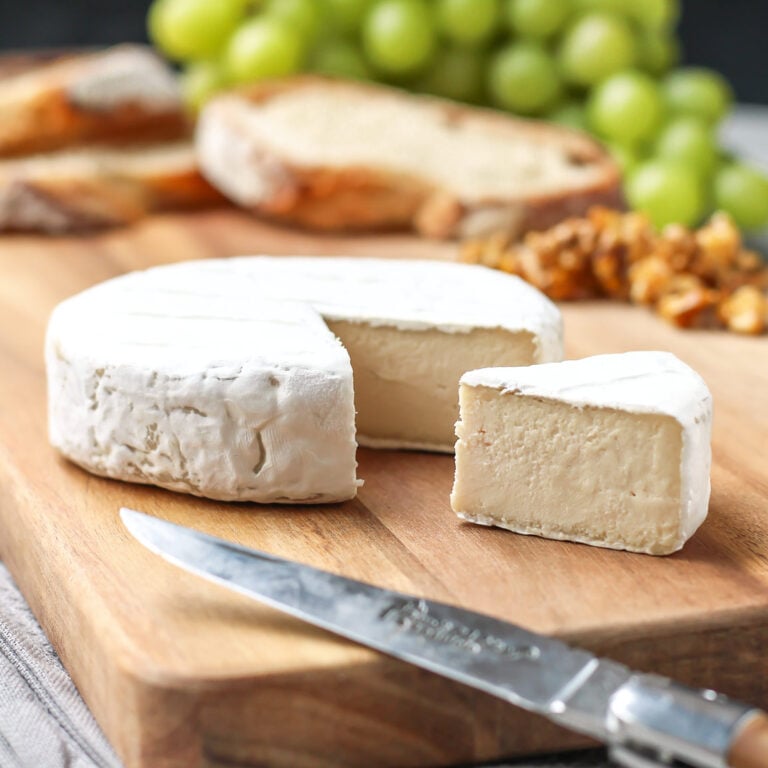
Vegan Aged Camembert Cheese
Ingredients
- 4 cups (600 g) raw cashews soaked overnight
- 8-10 tbsp (120-150 ml) filtered water (or boiled water cooled down)
- 8 capsules Acidophilus probiotic or 1/8 tsp mesophilic
- 1/8 tsp Penicillium Candidum powder or liquid
- 2 tsp (10-15 g) sea salt
Instructions
Prepare the cashew cream
- Drain the cashews and place them in a large glass bowl. Bring a large pot of water to a boil. Once boiling, pour the water directly onto the cashews. Let sit 1-2 minutes, and drain the cashews again. This step will help kill possible bacteria.
- Place the cashews in the bowl of a blender or food processor. Add 8 tablespoons of filtered water. Blend on high speed, scraping down the sides from time to time, until you get a very smooth cream. This step might take about 10 minutes, depending on your blender.
- Open the probiotic capsules and add the powder to the blender. Add the Penicillium Candidum, and blend on high speed for another 10-15 seconds.
- The cashew cream should be smooth but quite thick. If needed, add 1 tablespoon of water at a time until smooth. Do not add too much water or your mixture will be too liquid.
- Let it ferment: Transfer the cashew cream to a clean glass bowl, cover it with plastic film to touch, and let it sit at room temperature for 24-48 hours in a dark place. This step is important to let the cheese ferment and get a tangy flavor. Note: The cashew cream should have small bubbles and a fluffy texture. This means the fermentation process worked.
- Transfer the cashew cream to the refrigerator and chill for at least 4 hours (or overnight). The cashew cream will firm up a bit and become easier to work with.
Shape the cheeses
- Line 3 4-inch springform pans with parchment paper. You want to cover the bottom and sides. Alternatively, you can also use plastic film if you prefer. The goal is to prevent the cheese from touching the metal. Fill each pan with the cashew cream and press it down using plastic film, so it doesn't stick to your hands. Refrigerate overnight.
- The next day, carefully remove the cheeses from their springform pans and place them in a container lined with parchment paper.
- Sprinkle about 1/4 tsp of salt over the top of the cheeses. Next, using a plate lined with parchment paper, very carefully flip the cheeses. Sprinkle the tops and sides with more salt. The cheeses will still be very soft, like cream cheese. Don't worry, they will be easier to work with after 3-4 days, as salt will remove some moisture.
Aging
- Close the container and place it in your refrigerator (in the warmest area) or a room at a temperature of 52-56°F (11-13°C). Important note: You will age the cheeses at this temperature for the next two weeks. Do not store them at a temperature higher than 56°F (13°C). Also, the cheeses must stay in the closed container during the whole process, it will prevent them from drying.
- Every day, carefully flip the cheeses. Always use clean hands or work with gloves (or plastic film) to make sure you are not touching the cheeses. If you see water or condensation in the container, remove it using a kitchen paper towel.
- After 7 days, the cheeses will be a little bit firmer, and you should be able to place them on a plastic grid or chopsticks (that fits inside your container). This will allow airflow, and the mold will grow more uniformly.
- Continue flipping the cheeses every day for the next 7 days. The mold will start to appear in the following days, if it hasn't appeared already.
- After a total of 2 weeks, the cheeses should be completely covered with a white and fluffy mold. At this point, wrap the cheeses in parchment or cheese paper and place them in the refrigerator for at least 2 days. The longer you let them age in the refrigerator, the sharper they will become.
- Enjoy this vegan camembert with french bread, fresh figs, and/or nuts!
- Vegan camembert will keep for up to 1 month in the refrigerator.
Video

Notes
- Do not omit or substitute any ingredient. This recipe is not versatile. If you want to succeed with it, do not change the ingredients or method.
- Use gloves. While not mandatory, I recommend using gloves while handling the cheeses. It will prevent bad bacteria from contaminating your cheeses.
- Regarding the Penicillium Candidum: The links provided here for Penicillium Candidum may not redirect to a fully vegan product. If you want to find a 100% vegan one, you will have to do your own research (it’s available in many cheese-making shops). Be aware that non-vegan ones are grown on lactose, meaning it contains *traces* of lactose. Considering the amount used, you could still consider your cheese 99,99% vegan. It’s up to you to choose which one fits your beliefs best.
- Penicillium Candidum can be found in powdered and liquid forms. Both work the same. I usually use 1/8 tsp when in liquid or 1/16 tsp when in powder. If you do not own a 1/8 tsp, simply measure the powder using a fork or knife tip.
- Regarding the Acidophilus: In this recipe, I used the Advanced Acidophilus Plus from Solgar, which contains 500M microorganisms per capsule. You can use a different brand, but you may have to use less if it contains more microorganisms. Alternatively, you can replace the acidophilus with 1/16 teaspoon of mesophilic, which is a culture made specifically for cheese making. It will yield a slightly less tangy and more buttery flavor.
- Depending on the temperature in your fridge/aging room, the mold might take more or less time to develop. The colder the temperature, the longer it will take to develop.
Nutrition

About the Author
Thomas Pagot is the founder, photographer, and recipe developer behind Full of Plants. He created the blog in 2016 as a personal cookbook for vegan recipes. Through years of recipe development, Thomas has successfully grown Full of Plants into a trusted resource for plant-based recipes.




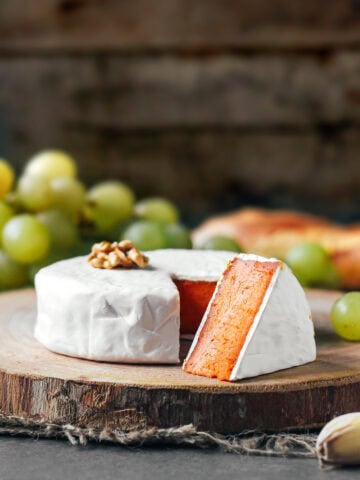
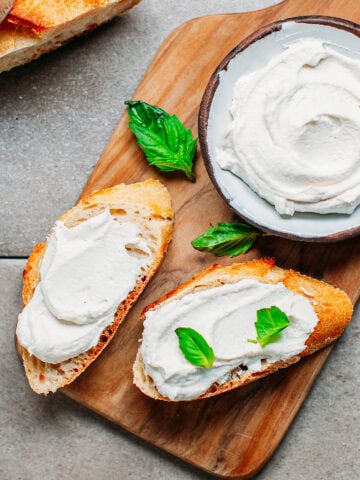
Leave a Comment
Hey Thomas, many many thanks for sharing this awesome recipe ! I’ve made quite a few batches now of both camembert and Roquefort and I have to say it works beautifully !
I have a quick technical question though : Once my cashew/nut cream is blended, it gets very warm at around 75°C which makes me think it could kill the penicilium and possibly the acidophilus too. So far I have always waited for it to cool down to around 35°C before pitching both of them, which takes more or less 5h (I just leave the blender bowl in the coolest place of my house). I’m struggling to find online some informations about the maximum pitching temperature in order not to kill the penicilum and/or the acidophilus. As a beer brewer I know that 35/40°C seems to be the ideal temp for a lactofermentation, but I’m not sure about penicilum.
Any chance you’ve got the answer to my questions ?
Thanks in advance !
Hi Nathan,
You’re welcome! That is a very good question and unfortunately I couldn’t find much information about that either. From what I read, it seems that over 60° may kill the mold, but nothing seems very clear. I’m surprised that your cashew cream reaches that high temperature though, may I ask what kind of blender you are using?
In my opinion, your best option is to blend your cashew cream without any penicillium candidum or starter culture. Transfer the cashew cream to a clean bowl and cover it with plastic wrap touching the top of the cream (to prevent it from drying). Then, a few hours later, incorporate the cultures and mix to combine.
Hey Thomas, thanks a lot for your very kind answer and your time. It looks like we both came across the same source of informations ! Until I know more (If I do I’ll share everything here, of course), I think I’ll stick to my 35°C-ish cooling method, just to be safe.
Regarding the blender, I use a pretty decent Ninja. It’s not great but it does the job. I sterilize the bowl with boiling water before adding straight away the cashews (also sterilized with boiling water), which surely explain the high temperature. It’s probably overkill 😉 I should simply wait a bit longer until both the cashews and the bowl itself cool down to room temp before blending.
One last thing : I reckon in my case I’ll leave the cream to cool down inside the blender and then pitch and blend again instead of transfering to a bowl as I have reduced the water ratio in order to make my cheeses firmer. I like it better like that but it’s just slightly too thick to mix properly by hand.
Again thanks a lot !
Looking forward to try other cheeses recipes of yours !
Nathan
This recipe is great. I have made both the original and the sun dried tomato version. Then I made mini camandbert cheeses with macadamia nuts instead of cashews and they all turned out really well.
I’m happy to hear you had success making both kinds of camembert! Thanks for your feedback Liam, I appreciate it 🙂
Hello!
ı started doing it and just salted my cashew cream. But it has black dots like crushed pepper corns. It doesnt look like molds and it already been 3-4 days. Should i worry?
Hello Yasemin,
Scrape off the black mold and add a pinch of salt on those areas. If there is really a lot of black mold, I’m afraid you will have to start again.
I am not sure if its mold actually. It just gave 1 little white mold on the side and these are like little dots. And they have been there since day 2. Could it grow mold in day 2?
It doesn’t look like mold to be honest. It looks like it might be some parts of the cashew husk. Did you notice some black parts on your cashews?
If that’s the case, you shouldn’t worry about it.
That happened to me too and definitely didn’t develop as mold, I thought that since my cashews weren’t peferctly blended the coarser parts got a bit oxidized. In my case those tiny black spots were only on the outer surface
hi thomas, thank you for the recipe, it seems amazing! I’ve just salted my first batch and put it in the fridge. I have a question: do the chopsticks that I’ll use in the following days have to be placed higher than the bottom of the container? do you have a photo of that part? I’m a bit confused
Hi Ari,
The chopsticks are placed directly on the bottom of the container so when the wheels are placed on top of the chopsticks, there is some gap between the bottom of the container and the cheeses. It’s to allow the mold to grow more evenly and faster on both sides.
You answered a question of mine the other day (thank you!!) and now I’m back with another. Is it safe to eat more than a taste of the cheese in the initial fermentation stages? My cheese fermented for 48 hrs, has now been in the fridge a day, and I just formed into molds. But it’s delicious already! Tastes like cream cheese!! Do you know if its unsafe for any reason to consume some more the cheese before it’s more fermented? I’ll also mention that i think it’s already gotten a tiny film of good white mold at this point.
It’s definitely safe!
I followed your recipe to a T and it turned out horribly. I’m a cheesemaker and I made my Cams the week previously, so I know the process. My cultures were fine because my non-vegan Cam is developing the bloomy white beautifully. But this one turned blue two days later. Shame. My hubby is vegan and he was really looking forward to this.
Hi Rain,
Sorry to hear you had trouble with this camembert recipe. I am unsure what happened with your cheese, without additional information it’s hard to say but it probably got contaminated somehow. What is that blue carpet under the cheese? I doubt this is a good idea, it will trap moisture and bacteria.
I removed your 1 star rating as hundreds of non-cheesemakers had success making their cashew camembert using this recipe. And they followed the recipe to a T as well.
As a cheesemaker Thomas, I know how to make cheese. I’ve successfully made Cheddars, Cams, Fontinas, Bries, Mozzarellas, Parms, Colby, Chevre, Monterey Jack, Sour Creams, Yogurts and Mascarpones. The blue towel was under the container simply for the picture. I have a cheese cave. I know you don’t like to have negative reviews, but the proof is in the result. I don’t think this is a good recipe and I’m sorry you felt the need to remove my one star rating. People need to know. Take care.
Hi. After a first batch that developed some pink mold, my second batch came out fantastic! Question: you mention using a plastic grid or chopsticks to provide circulation during the aging process. On my second batch, I used bamboo sushi mat, but I have some stainless steel racks that fit perfectly in the container I used and that are much easier to clean than the bamboo… any problem with using metal?
Hi Michael,
I’m happy to hear you are having success with the recipe 🙂
I agree, a bamboo mat is not the easiest to use and clean. I usually use plastic grids. I don’t think stainless steel racks should be a problem, but I have never personally tried so I’m unsure if they would impart a metallic taste or not to the cheeses.
OK, thanks. Since you mentioned not letting the cheese touch the sides of the springform molds, I was not sure if there would be some negative reaction between metal and the cultures. I suspected not, but wanted to make sure.
Hi, very excited to try this recipe! However, like some other people, I am confused about the fridge temps. Do all the hundreds of people making this have a special wine fridge? Cause I don’t think regular fridges will go above the low 40s (F)… unless they are broken. So are people just proceeding at that lower temp (40ish)? Or are people hacking their fridge somehow to make it warmer? I’m curious to hear from Full of Plants but also just curious to hear other readers’ experiences.
Hi Charlotte,
Well, mine can go up to 55°F and so many other brands of fridges. You can still get great results with a fridge set at a temperature of around 46°F (8°C).
Oh, well I stand corrected then! I’ll have to take a look at my family’s extra fridge in this case! Thanks for replying.
Hi, I tried the recipe, I have a wine cooler which met the temperature needs, I cleaned the fridge before and sanitized the equipment in the dishwasher before using, my cheeses are molding however… they are about a week in, and I’m seeing some spots. Any tips on why that might be?
Hi Danielle,
What kind of mold are you seeing? If it looks like white patches, this is totally normal, it’s the penicillium candidum growing.
If you are seeing blue or grey/black spots, then you should scrape those off and resalt the area. Are you using gloves while handling the cheeses?
Hi, Thomas!
I love your recipe and have made various kinds of vegan cheese for many years.
I just realized that the amount of cultures in your recipe is much more than the ones shown on the package of the culture/mold. Is there any reason that we ought to use more culture/mold than making dairy cheese?
Thank you!
Kana
Hi Kana,
Well, first cashew cheeses do not require curdling and draining, that’s one thing.
The main thing though, is that the recipes I am sharing only make 3-4 cheeses. So it would be extremely difficult for most readers to measure less than 1/8 teaspoon of culture. You are right though, there is no need to use that much cultures. For example, if you double the recipe, you will not need to double the amount of cultures as it’s already more than enough.
Hi Thomas, I’ve been eyeing this recipe for months and am so excited to finally try it! My concern is the ageing temp. The warmest part of our fridge is 6-7 C. Our basement is a steady 14C. We bought a small wine fridge last week, and dismayed to see despite claiming a range between 6 – 16C we can’t get it above 8C, so we are returning it.
We have an cool pantry cupboard that is currently 11C degrees, but the temp fluctuates with outside temp, and will get colder overnight.
The cheeses come out of their molds today.
Will our basement’s 14C be too warm to age the cheeses in a sealed container?
Hi Susan,
That’s a hard pick! I would suggest using your pantry cupboard if it doesn’t get much higher in temperature, otherwise use your basement.
14°C is a bit higher than usual to age camembert but here is what I would do. Age them at this temperature for 6-8 days or until they are fully covered (or at least 95% covered) before transferring them to your fridge and aging them for another week or so. At 14°C, the Penicillium Candidum should grow pretty fast.
We did! The pantry has stayed in the 11C range and the cheeses have molded beautifully! There were just a few small spots left to cover, so I tried putting them upon chopsticks for better circulation. They were already on a grate in a Tupperware container, so in hindsight this probably wasn’t necessary. I took them out to wrap and put in the fridge on Sunday, and horrors, they stuck to the chopstick 🙁 I pried the sticks out, and back into the pantry for a couple of days and the mold does seem to be filling in. Tried to attach a pic, but didn’t work.
I’ll wrap them tomorrow, if the lines are still there, serve them right-side up! Has your cheese stuck to a chopstick? I won’t do it again. But huge thank you Thomas for this recipe XXXX
Awesome! I’m so happy to hear you had success with this camembert, Susan!
Yes, it happened to me as well. That’s why I’m not using a thin plastic grid instead. A quick tip: you can wrap your chopsticks with plastic wrap and your problem will be fixed 😉
Sorry me again I e tried a second batch but it has been 2 weeks and no mould has appeared, I added some more penicillin candidum to water and salt and have spritzed the cheeses 3 days ago and still no mould, any other tips? Thank you
I would suggest going through the comments on this page as there is a ton of useful information.
But again, when mold is not growing it almost always comes from 2 issues: the aging temperature is too cold or your cheeses dried too quickly and formed a crust, preventing the mold from growing.
do you have any idea why the mold is not white but grey? i don t understand, i do everything right and it s grey, doesn t matter which penicillium i use
Hi Emilie,
This is not good mold, please trash your cheeses and start again.
You should use penicillium candidum, but more importantly my suggestion would be to use gloves while handling the cheeses and utensils. Also, you might want to clean completely your fridge and boxes. Change the bamboo mat too. At which temperature are your cheeses aging?
Hello, I just wondered if you have ever added any truffle oil to the mixture? Thx
Hello Matthew,
I haven’t but you can definitely add a 2-3 teaspoons for extra flavor!
Hi Thomas!
I wanna Hello, Thomas. I wanna to make this Camembert cheese, but in Vietnam, Penicillium candidum is not available. So, can I use a type of Vegetarian rennet?
Hi Tăng Yến,
Vegetarian rennet is not the same as Penicillium candidum. If you don’t have access to it, you could for example, use 1 tablespoon of the rind of a dairy camembert and blend it with the cashew cream. I know your cheese won’t be 100% vegan but it’s the best option if you cannot buy PC.
Hello. I have started my first batch of this cheese and am wondering: when I ground the soaked and sterilized cashews in my Vitamix, the nut paste became quite warm (I should have used more water, perhaps?). I went ahead and added the cultures but am curious if the warm temperature and low liquid content may have negatively affected the outcome. After the 48-hour room fermentation, there was none of the fluffiness that the picture indicates (though there was a bit of a tasty tang to the mixture). They are currently in the springform molds in the refrigerator, but I am thinking this first attempt may be botched; any thoughts? Thanks, Michael.
Hello Michael,
If the paste becomes warm, I recommend taking a break before blending again.
Regarding the outcome, I doubt that the warm temperature will affect it. You don’t have to get the same fluffiness as shown on the photo (especially if your cashew paste is thick). As long as the cashew mixture seems slightly fluffy, has a subtle tang and smells like yogurt/cream cheese, you are good to go. Hope your cheeses will turn out great, keep me updated 🙂
Thanks Thomas, much appreciated. Flipping is preceding along fine but, since I am using a standard cold refrigerator, aging will probably take quite a while; will report in once white mold starts appearing.
Hi, I’m trying this recipe for the first time. My cheeses are aging in the fridge. Do you think it’s okay if I skip the flip for 1-3 days?
Hi Anne,
If your cheeses are placed on a grid or on chopsticks, you can skip the flipping step for 2-3 days without any problem.
Hi, thanks for the lovely recipe. All good but I get a bitter rind every time. It lingers in the throat and makes it difficult to enjoy. How can I make the rind be as subtle as possible, like you say, flowery rather than bitter 🙂 What could be the reason for this. Thank you
Hi Karine,
I would recommend trying a different culture and mold. Not all probiotics are equals and some may yield a bitter flavor (I personally love to use mesophilic and penicillium candidum Neige). Also, you may try reducing slightly the temperature of your fridge, a warmer aging temperature will yield a stronger flavor.
Thanks Thomas. I’ve tried various cultures and PC molds but still get a bitter rind. Wonder if I’m letting too much white grow or the fact that I let it dry(8C/65%) for several hrs before being wrapped could be the issue? Thanks
I’m not sure what you mean by letting it dry for several hours, but usually the longer you let it age, the stronger it will become. The bitterness might come from that, although I never had this type of issue.
Hi Thomas, I am very excited to try this recipe. I am based in South Africa and really struggling to find the Acidophilus. I have managed to find a vegan yoghurt culture and wanted to know if you think this would work? See the description of the culture below.
Lyofast SYAB 1 consists of specifically selected strains of Streptococcus thermophilus and Lactobacillus delbrueckii ssp. bulgaricus added with the probiotic strains Lactobacillus acidophilus and Bifidobacterium lactis.
I have since actually managed to find what I think might be the correct probiotic.
I see that it contains more per serving so I will adjust quantity accordingly. Is this the correct thing to do?
Yes, in your case, you will need to use only 2 capsules as they contain 4 times the amount of the ones I recommended in this post.
Hi Thomas,
This is the probiotic I ended up using – https://www.greensquareshop.com/products/probiotic-supplements-acidophilus-tablets-digestive-gut-health
My cheeses are in a temperature controlled fridge (at 12 degrees Celsius) and they are each in their own containers. They have been aging for 3 days but are still very soft and their is water at the bottom of the containers everyday. I have placed paper towel in the containers but I’m not sure if this is a lost cause?
Hi Cindy,
I think I’ve seen this probiotic before in one of your other comments.
12 degrees Celcius is great for camemberts, the mold should grow pretty fast! Use kitchen paper towels to remove the water from the containers every 1-2 days and you should be good 😉
Hi Cindy,
Yogurt culture won’t work as it needs a higher temperature to ferment, it would also yield a different flavor. You want to use either the acidophilus or mesophilic culture, not thermophilic.
Is the measurement for the mesophilic 1/8 or 1/16 of a tsp? The ingredient list states 1/8 but your comments say 1/16.
1/16 teaspoon is more than enough, but I wrote 1/8 teaspoon as some readers had trouble understanding how to measure 1/16 teaspoon.
Hi Tomas, thanks for this wonderful recipe! I am just having a problem finding the right probiotics, unfortunately I only found some that have 25 billion per capsule.. in this case, should I use 1/6 of a capsule per batch?
Thanks!
Hi Ilaria,
Yes, I would recommend using just a pinch of 1/16 of a teaspoon.
Awesome, will do! Thank you so much
I’m a few weeks in and the white mold is still only covering about 75/80% of the cheese. Any idea of why this is and what I can do?
Is your cheese dry on the 20-25% not covered? If the mold stopped growing, the reason is almost always because the cheese formed a crust, hence it is not moist enough for the mold to grow.
Are you keeping your cheeses in a container?
I’m aging this in the fridge at the warmest place. I’m about 12 days into aging now, and I’m not sure if I’m having trouble. The fuzzy white mold appears, but then disappears after I flip it. As in, the top will be fuzzy, but when I flip it and it becomes the bottom, the bottom isn’t fuzzy the next day. Is this normal or should I maybe stop flipping it?
As explained in the recipe, you should transfer your camembert to a rack. That will allow the mold to grow evenly on top and bottom. It also makes it easier to flip as the mold won’t stick to any parchment paper. If you don’t have a small rack that can fit in your container, then you can use chopsticks 😉
Thank you for your reply! I do have it on a cheese mat in the container. Is it normal for the mold to come and go if it is aging in the fridge where it is colder than 56 degrees? I’m wondering if this is a normal part of the aging process when it is slower.
If it’s the kind of cheese mat made of bamboo, then I do not recommend using that anymore as the white mold tends to stick to it. There is also not enough area in contact with air for the mold to grow correctly on the bottom, that’s why I recommend a grid with large holes (or chopsticks). Regarding the temperature, yes, the colder the slower it will take for the mold to grow.
Hello Thomas,
I am very excited to try this! I have a question and apologize if you answered it, I could not find it.
Do you keep the cheese in the refrigerator during the whole process including the aging process? I appreciate your reply.
Hello Candy,
Yes, you should keep the cheeses in the refrigerator during the whole aging process.
Hey Thomas, me again.I just read that you only put 500M microorganism. Yesterday i didnt realize and put 2B in the mixture.Is this still salvable? Or do i better start over?
Hi Jan,
You will only know in a day or two, once the fermentation has started. If your cashew cream is too airy and has a rotten egg smell, something went wrong. On the other hand, if your cashew cream has a pleasant, lightly sour (like yogurt) taste, you can continue with the process.
Hello Thomas, I bought a small wine fridge where i will only put in the cheeses and nothing else. Is it necessary to have each cheese in its separate container, or is this something you recommend to avoid cross contamination with other foods if using a normal fridge? im planning to make +10 cheeses and would prefer not to have them all in a separate container
Hello Jan,
I recommend keeping cheeses in a container for a simple reason: to keep enough humidity and prevent the cheeses from drying on the outside before the mold can develop. If you can have a high percentage of humidity inside your wine fridge, then you shouldn’t need to keep the cheeses inside a container.
I have a stupid question. Is it 4 cups of raw cashews and then soak them overnight? Or is it 4 cups of raw cashews that have been soaked overnight. There’s a big difference in volume between the two.
It’s 4 cups of cashews before soaking.
Thank you so much! I want to make your blue cheese recipe. I would like to add juniper berries. Can I do that? I guess I would add them during the crumble phase? I’ve had blue cheese with Juniper berries in it before and it was so delicious.
Are they dried? Because I am unsure if it’s safe to add fresh berries to this cheese. I think they will turn bad.
Otherwise, if dried, yes. I would add them during the crumbling step.
Can you substitute macadamia nuts for the cashews? My husband has a cashew allergy.
I haven’t tried with macadamias so I cannot say for sure, but I believe the texture of the cream might be too liquid since macadamias contain more fat than cashews.
I hope you are still answering questions! I made this recipe last week. They came out of their pans on Friday (6 days ago), i rubbed salt on them and put them into my cold room which sits at ~12 degrees. I flipped them every morning and on Monday, the 4th day, there was substantial white mold on them and now, on day 6th, they are entirely covered. They look beautiful….but, I’m concerned about how quickly that happened. I’m a bit confused about the timing in your instructions…specifically, after you take them from the mold, after 7-10 days they will firm up and then place them on a clean grid at this point. Then keep flipping for another week and the mold will appear after 5-7 days. I’m interpreting this as: release from the mold, flip for 7-10 days and then transfer to a grid. Then flip for an other week, and during THAT week the mold will grow. So I was anticipating that the mold wouldn’t grow until around day 15. I hope I’m wrong and my timing is good! Thanks!
Hi Tracy,
Mold growth depends a lot on the aging conditions such as the temperature and humidity. You aged the cheeses at a rather warm temperature, that’s why the mold grew so quickly, nothing wrong about that 🙂
At this point, I would recommend wrapping your cheeses in special camembert paper and letting them age for at least 7-10 days in the refrigerator (at a lower temperature) before eating.
Sorry, Thomas, I still have a question. Can I use penicillum candidum or penicillum camemberti indifferently?
Yes, it’s basically the same thing.